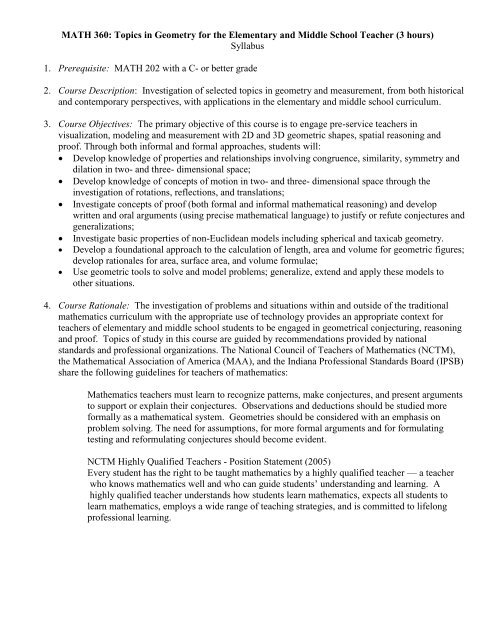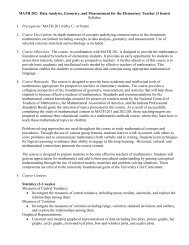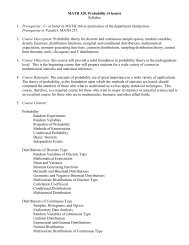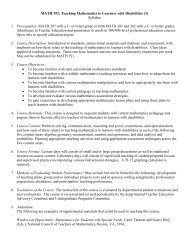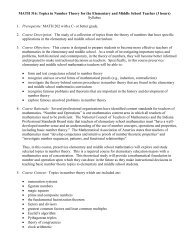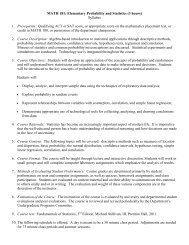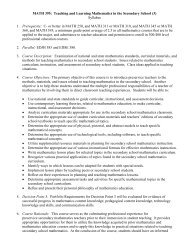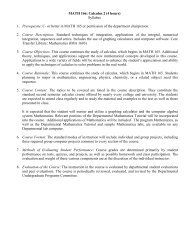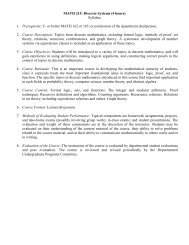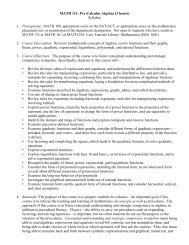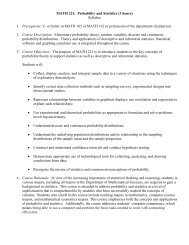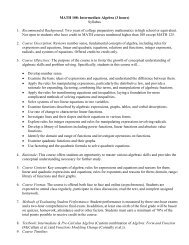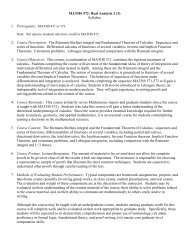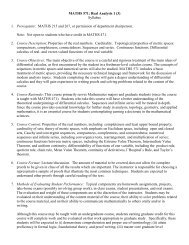Topics in Geometry for the Elementary and Middle School Teacher
Topics in Geometry for the Elementary and Middle School Teacher
Topics in Geometry for the Elementary and Middle School Teacher
Create successful ePaper yourself
Turn your PDF publications into a flip-book with our unique Google optimized e-Paper software.
MATH 360: <strong>Topics</strong> <strong>in</strong> <strong>Geometry</strong> <strong>for</strong> <strong>the</strong> <strong>Elementary</strong> <strong>and</strong> <strong>Middle</strong> <strong>School</strong> <strong>Teacher</strong> (3 hours)<br />
Syllabus<br />
1. Prerequisite: MATH 202 with a C- or better grade<br />
2. Course Description: Investigation of selected topics <strong>in</strong> geometry <strong>and</strong> measurement, from both historical<br />
<strong>and</strong> contemporary perspectives, with applications <strong>in</strong> <strong>the</strong> elementary <strong>and</strong> middle school curriculum.<br />
3. Course Objectives: The primary objective of this course is to engage pre-service teachers <strong>in</strong><br />
visualization, model<strong>in</strong>g <strong>and</strong> measurement with 2D <strong>and</strong> 3D geometric shapes, spatial reason<strong>in</strong>g <strong>and</strong><br />
proof. Through both <strong>in</strong><strong>for</strong>mal <strong>and</strong> <strong>for</strong>mal approaches, students will:<br />
Develop knowledge of properties <strong>and</strong> relationships <strong>in</strong>volv<strong>in</strong>g congruence, similarity, symmetry <strong>and</strong><br />
dilation <strong>in</strong> two- <strong>and</strong> three- dimensional space;<br />
Develop knowledge of concepts of motion <strong>in</strong> two- <strong>and</strong> three- dimensional space through <strong>the</strong><br />
<strong>in</strong>vestigation of rotations, reflections, <strong>and</strong> translations;<br />
Investigate concepts of proof (both <strong>for</strong>mal <strong>and</strong> <strong>in</strong><strong>for</strong>mal ma<strong>the</strong>matical reason<strong>in</strong>g) <strong>and</strong> develop<br />
written <strong>and</strong> oral arguments (us<strong>in</strong>g precise ma<strong>the</strong>matical language) to justify or refute conjectures <strong>and</strong><br />
generalizations;<br />
Investigate basic properties of non-Euclidean models <strong>in</strong>clud<strong>in</strong>g spherical <strong>and</strong> taxicab geometry.<br />
Develop a foundational approach to <strong>the</strong> calculation of length, area <strong>and</strong> volume <strong>for</strong> geometric figures;<br />
develop rationales <strong>for</strong> area, surface area, <strong>and</strong> volume <strong>for</strong>mulae;<br />
Use geometric tools to solve <strong>and</strong> model problems; generalize, extend <strong>and</strong> apply <strong>the</strong>se models to<br />
o<strong>the</strong>r situations.<br />
4. Course Rationale: The <strong>in</strong>vestigation of problems <strong>and</strong> situations with<strong>in</strong> <strong>and</strong> outside of <strong>the</strong> traditional<br />
ma<strong>the</strong>matics curriculum with <strong>the</strong> appropriate use of technology provides an appropriate context <strong>for</strong><br />
teachers of elementary <strong>and</strong> middle school students to be engaged <strong>in</strong> geometrical conjectur<strong>in</strong>g, reason<strong>in</strong>g<br />
<strong>and</strong> proof. <strong>Topics</strong> of study <strong>in</strong> this course are guided by recommendations provided by national<br />
st<strong>and</strong>ards <strong>and</strong> professional organizations. The National Council of <strong>Teacher</strong>s of Ma<strong>the</strong>matics (NCTM),<br />
<strong>the</strong> Ma<strong>the</strong>matical Association of America (MAA), <strong>and</strong> <strong>the</strong> Indiana Professional St<strong>and</strong>ards Board (IPSB)<br />
share <strong>the</strong> follow<strong>in</strong>g guidel<strong>in</strong>es <strong>for</strong> teachers of ma<strong>the</strong>matics:<br />
Ma<strong>the</strong>matics teachers must learn to recognize patterns, make conjectures, <strong>and</strong> present arguments<br />
to support or expla<strong>in</strong> <strong>the</strong>ir conjectures. Observations <strong>and</strong> deductions should be studied more<br />
<strong>for</strong>mally as a ma<strong>the</strong>matical system. Geometries should be considered with an emphasis on<br />
problem solv<strong>in</strong>g. The need <strong>for</strong> assumptions, <strong>for</strong> more <strong>for</strong>mal arguments <strong>and</strong> <strong>for</strong> <strong>for</strong>mulat<strong>in</strong>g<br />
test<strong>in</strong>g <strong>and</strong> re<strong>for</strong>mulat<strong>in</strong>g conjectures should become evident.<br />
NCTM Highly Qualified <strong>Teacher</strong>s - Position Statement (2005)<br />
Every student has <strong>the</strong> right to be taught ma<strong>the</strong>matics by a highly qualified teacher — a teacher<br />
who knows ma<strong>the</strong>matics well <strong>and</strong> who can guide students’ underst<strong>and</strong><strong>in</strong>g <strong>and</strong> learn<strong>in</strong>g. A<br />
highly qualified teacher underst<strong>and</strong>s how students learn ma<strong>the</strong>matics, expects all students to<br />
learn ma<strong>the</strong>matics, employs a wide range of teach<strong>in</strong>g strategies, <strong>and</strong> is committed to lifelong<br />
professional learn<strong>in</strong>g.
5. Course Content: The content of this course will emphasize a problem-solv<strong>in</strong>g approach that <strong>in</strong>cludes<br />
generat<strong>in</strong>g hypo<strong>the</strong>ses <strong>and</strong> prov<strong>in</strong>g or disprov<strong>in</strong>g conjectures. Required topics of study are:<br />
Proofs of Euclidean constructions, basic <strong>the</strong>orems, <strong>and</strong> properties of special quadrilaterals <strong>and</strong> o<strong>the</strong>r<br />
polygons. Basic <strong>the</strong>orems <strong>in</strong>clude <strong>the</strong> angle sum <strong>in</strong> a triangle <strong>the</strong>orem, circle congruence <strong>the</strong>orems,<br />
<strong>and</strong> po<strong>in</strong>ts related to <strong>the</strong> Euler l<strong>in</strong>e. Both syn<strong>the</strong>tic <strong>and</strong> coord<strong>in</strong>ate proofs are <strong>in</strong>cluded.<br />
The study of trans<strong>for</strong>mations as a composition of reflections <strong>and</strong> as operations with matrices.<br />
The study of trans<strong>for</strong>mations, dilations <strong>and</strong> symmetry <strong>in</strong> <strong>the</strong> context of planar <strong>and</strong> spatial fractals.<br />
In-depth study of <strong>the</strong> Pythagorean Theorem as a biconditional <strong>the</strong>orem, common proofs, <strong>and</strong><br />
applications.<br />
An <strong>in</strong>troduction to <strong>the</strong> historical development <strong>and</strong> characteristics of spherical geometry (i.e. <strong>the</strong> sum<br />
of <strong>the</strong> measures of <strong>the</strong> angles of a triangle, <strong>the</strong> parallel postulate).<br />
An <strong>in</strong>troduction to taxicab geometry.<br />
The development <strong>and</strong> rationale <strong>for</strong> area, surface area, <strong>and</strong> volume <strong>for</strong>mulae; accurate computation<br />
with st<strong>and</strong>ard <strong>and</strong> nonst<strong>and</strong>ard units.<br />
Two- <strong>and</strong> three- dimensional physical models, draw<strong>in</strong>gs, <strong>and</strong> dynamic geometry environments (e.g.<br />
Logo, Geometers Sketchpad, GeoGebra), emphasiz<strong>in</strong>g visualization <strong>and</strong> conjecture.<br />
6. Course Format: Investigations, <strong>in</strong>teractive discussion <strong>in</strong> large <strong>and</strong> small groups, computer labs, <strong>and</strong><br />
lecture.<br />
7. Methods of Evaluat<strong>in</strong>g Student Per<strong>for</strong>mance: Attendance, <strong>in</strong>-class assignments <strong>and</strong> projects, homework<br />
assignments <strong>and</strong> projects, quizzes, exams.<br />
8. Evaluation of <strong>the</strong> Course: Instruction <strong>in</strong> <strong>the</strong> course is evaluated by departmental student evaluations <strong>and</strong><br />
peer evaluation. The course is reviewed <strong>and</strong> revised periodically by <strong>the</strong> Departmental Ma<strong>the</strong>matics<br />
<strong>Teacher</strong> Education Committee <strong>and</strong> <strong>the</strong> Undergraduate Programs Committee.<br />
[2/2001, Whitaker, Roebuck; 4/2012, Contreras, Emert, Shafer; Spr<strong>in</strong>g 2013, UPC R. Pierce Chair]


